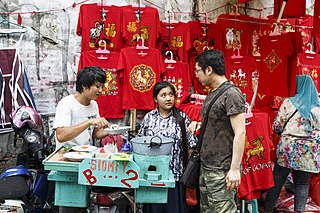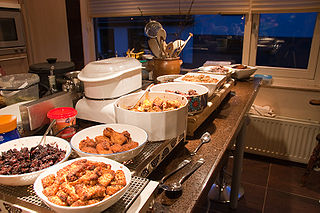
Indonesian cuisine is a collection of various regional culinary traditions that formed in the archipelagic nation of Indonesia. There are a wide variety of recipes and cuisines in part because Indonesia is composed of approximately 6,000 populated islands of the total 17,508 in the world's largest archipelago, with more than 1,300 ethnic groups.

A warung is a type of small family-owned business — small retail, eatery, or café — in Indonesia. A warung is an essential part of daily life in Indonesia. Over time, the term warung has shifted somewhat — especially among foreign visitors, expatriates, and people abroad — to refer more specifically to a modest Indonesian eatery or a place that sells Indonesian retail items. But for the majority of Indonesians, it still refers to a small, neighborhood convenience shop, often a front room or booth in a family's home.

Chinese Indonesian cuisine is characterized by the mixture of Chinese with local Indonesian style. Chinese Indonesians, mostly descendant of Han ethnic Hokkien and Hakka speakers, brought their legacy of Chinese cuisine, and modified some of the dishes with the addition of Indonesian ingredients, such as kecap manis, palm sugar, peanut sauce, chili, santan and local spices to form a hybrid Chinese-Indonesian cuisine. Some of the dishes and cakes share the same style as in Malaysia and Singapore, known as Nyonya cuisine by the Peranakan.

Bakmi or bami is a type of wheat based noodles derived from Chinese cooking tradition. It was brought to Indonesia by Chinese immigrants from Southern Chinese provinces like Fujian. It is typically prepared seasoned in soy sauce and topped with pork products, which is often substituted for other protein sources in predominantly Muslim Indonesia. Chinese-style wheat noodles has become one of the most common noodle dishes, especially in Southeast Asian countries which have significant Chinese populations and known by various names.

Mie goreng, also known as bakmi goreng, is an Indonesian stir-fried noodle dish. It is made with thin yellow noodles stir-fried in cooking oil with garlic, onion or shallots, fried prawn, chicken, beef, or sliced bakso (meatballs), chili, Chinese cabbage, cabbages, tomatoes, egg, and other vegetables. Ubiquitous in Indonesia, it is sold by food vendors from street hawkers (warungs) to high-end restaurants.

Fried onions are slices of onions that are either pan fried (sautéed) or deep fried — and consumed as a popular snack food, garnish, or vegetable accompaniment to various recipes.

Bakso or baso is an Indonesian meatball, or a meat paste made from beef surimi. Its texture is similar to the Chinese beef ball, fish ball, or pork ball. The word bakso may refer to a single meatball or the complete dish of meatball soup. Mie bakso refers to bakso served with yellow noodles and rice vermicelli, while bakso kuah refers to bakso soup served without noodles.

Javanese cuisine is the cuisine of Javanese people, a major ethnic group in Indonesia, more precisely the province of Central Java, Yogyakarta and East Java.

Batagor is a Sundanese dish from Indonesia, and popular in Southeast Asia, consisting of fried fish dumplings, usually served with peanut sauce. It is traditionally made from minced tenggiri, although other types of seafood such as tuna, mackerel, and prawn may also be used. The fish paste is subsequently stuffed into wonton skins or filled into tofu, and then deep-fried in palm oil.

Soto mie, Soto mi, or Mee soto is a spicy Indonesian noodle soup dish commonly found in Indonesia, Malaysia, and Singapore. Mie means noodle made of flour, salt and egg, while soto refers to Indonesian soup. In Indonesia, it is called soto mie and is considered one variant of soto, while in Malaysia and Singapore it is called mee soto.

Kwetiau goreng is an Indonesian style of stir fried flat rice noodle dish. It is made from noodles, locally known as kwetiau, which are stir-fried in cooking oil with garlic, onion or shallots, beef, chicken, fried prawn, crab or sliced bakso (meatballs), chili, Chinese cabbage, cabbages, tomatoes, egg, and other vegetables with an ample amount of kecap manis. In Asia, kwetiau is available in two forms, dried and fresh. Its recipe is quite similar to another Chinese Indonesian favourite, mie goreng, with the exception of replacing yellow wheat noodles for flat rice noodles.

Mie ayam, mi ayam, or bakmi ayam is a common Indonesian dish of seasoned yellow wheat noodles topped with diced chicken meat. It is derived from culinary techniques employed in Chinese cuisine. In Indonesia, the dish is recognized as a popular Chinese Indonesian dish, served from simple travelling vendor carts frequenting residential areas, humble street-side warung to restaurants.

Betawi cuisine is rich, diverse and eclectic, in part because the Betawi people that create them were composed from numbers of regional immigrants that came from various places in the Indonesian archipelago, as well as Chinese, Indian, Arab, and European traders, visitors and immigrants that were attracted to the port city of Batavia since centuries ago.

Seblak is an Sundanese savoury and spicy dish, originating from the Sundanese region in West Java, Indonesia. Made of wet kurupuk cooked with protein sources in spicy sauce. Seblak is a specialty of Bandung city, West Java, Indonesia. Seblak can be acquired from restaurants, warungs or gerobak (cart) street vendors. It is one of the most popular street foods in Indonesia, especially in Bandung and Jakarta.

Bawang goreng is an Indonesian crispy fried shallot condiment, commonly deep-fried, and a popular garnish to be sprinkled upon various dishes of Indonesian cuisine. It is quite similar to a crisp fried onion.

Kwetiau ayam, kuetiau ayam or sometimes kwetiau ayam kuah is a common Chinese Indonesian dish of seasoned flat rice noodles topped with diced chicken meat. It is often described as a kwetiau version of the popular mie ayam, and especially common in Indonesia, and can trace its origin to Chinese cuisine.

Indonesian noodles are a significant aspect of Indonesian cuisine which is itself very diverse. Indonesian cuisine recognizes many types of noodles, with each region of the country often developing its own distinct recipes.

Indo cuisine is a fusion cooking and cuisine tradition, mainly existing in Indonesia and the Netherlands, as well as Belgium, South Africa and Suriname. This cuisine characterized of fusion cuisine that consists of original Indonesian cuisine with Eurasian-influences—mainly Dutch, also Portuguese, Spanish, French and British—and vice versa. Nowaday, not only Indo people consume Indo cuisine, but also Indonesians and Dutch people.

Mie bakso is an Indonesian noodle soup dish consists of bakso meatballs served with yellow noodles and rice vermicelli. This dish is well known in Chinese Indonesian, Javanese and Malay cuisine. Mie bakso is almost identical with soto mie, only this dish has meatball instead of slices of chicken meat.


























































